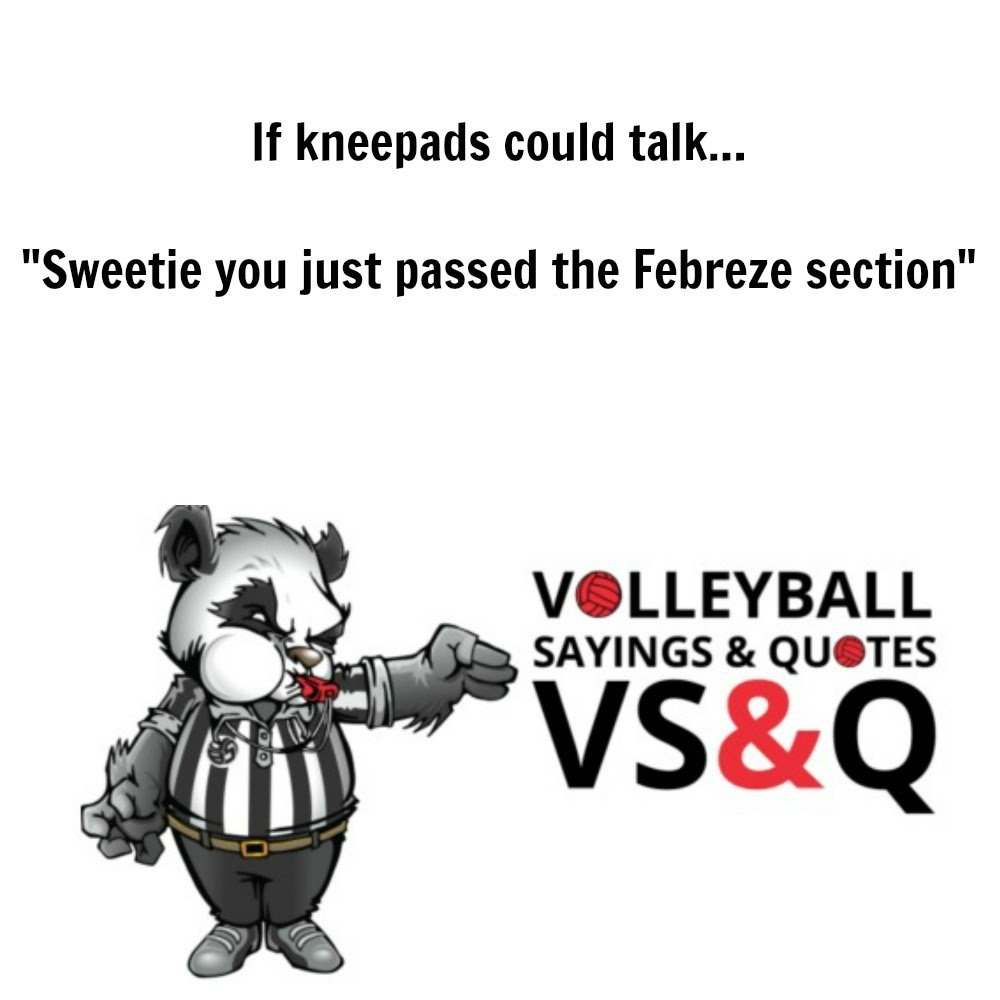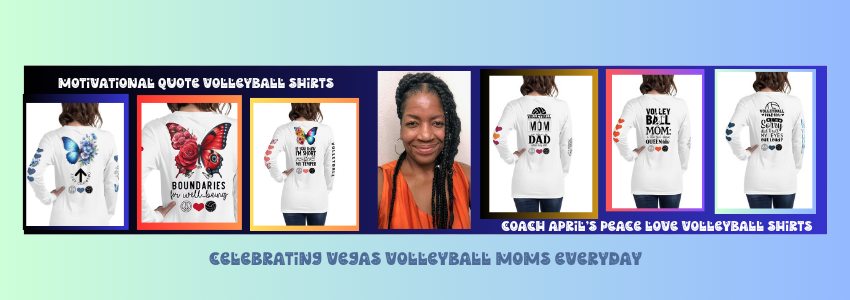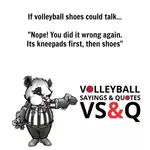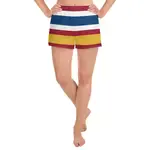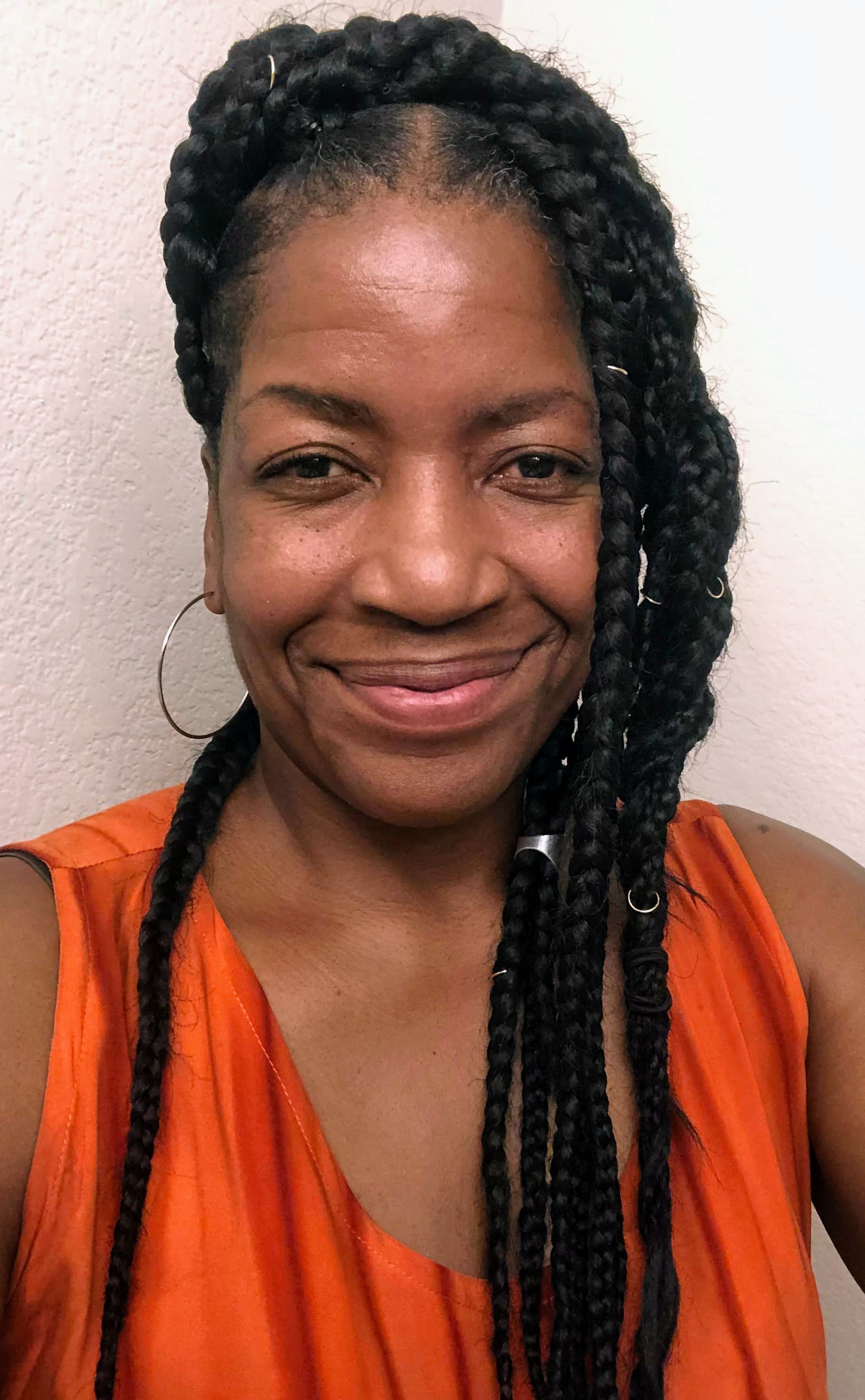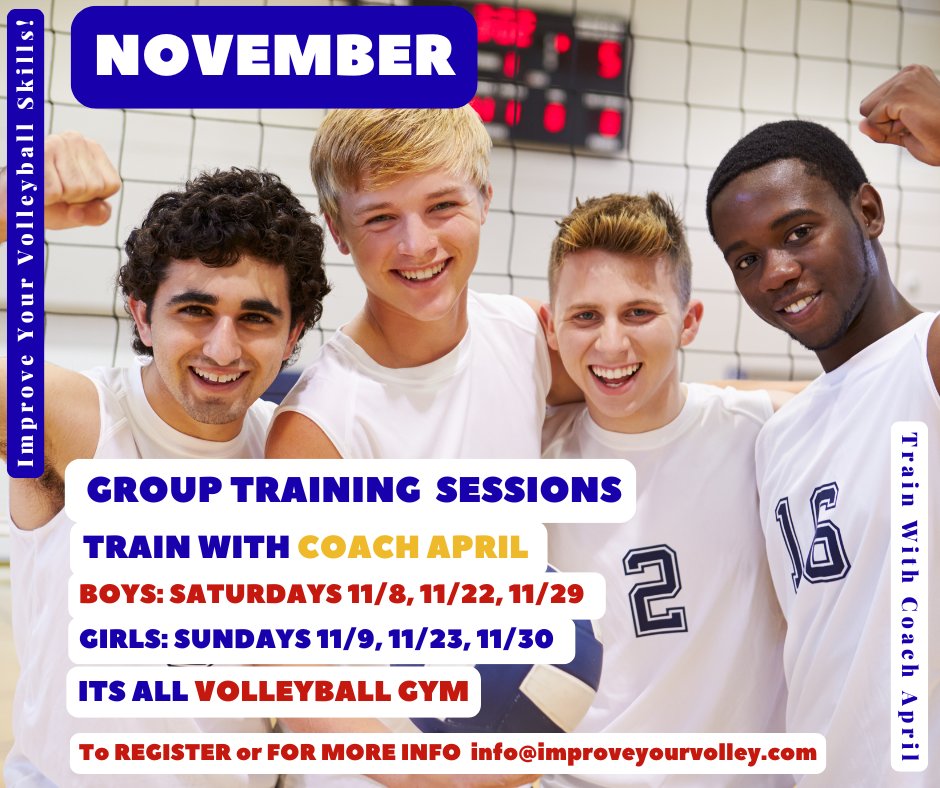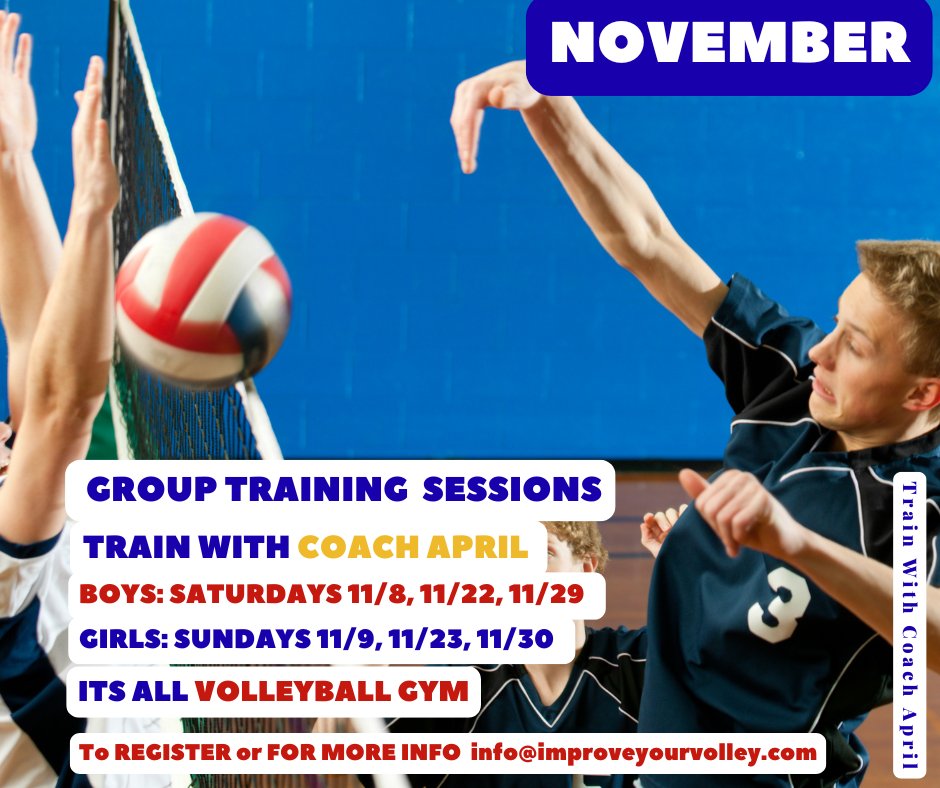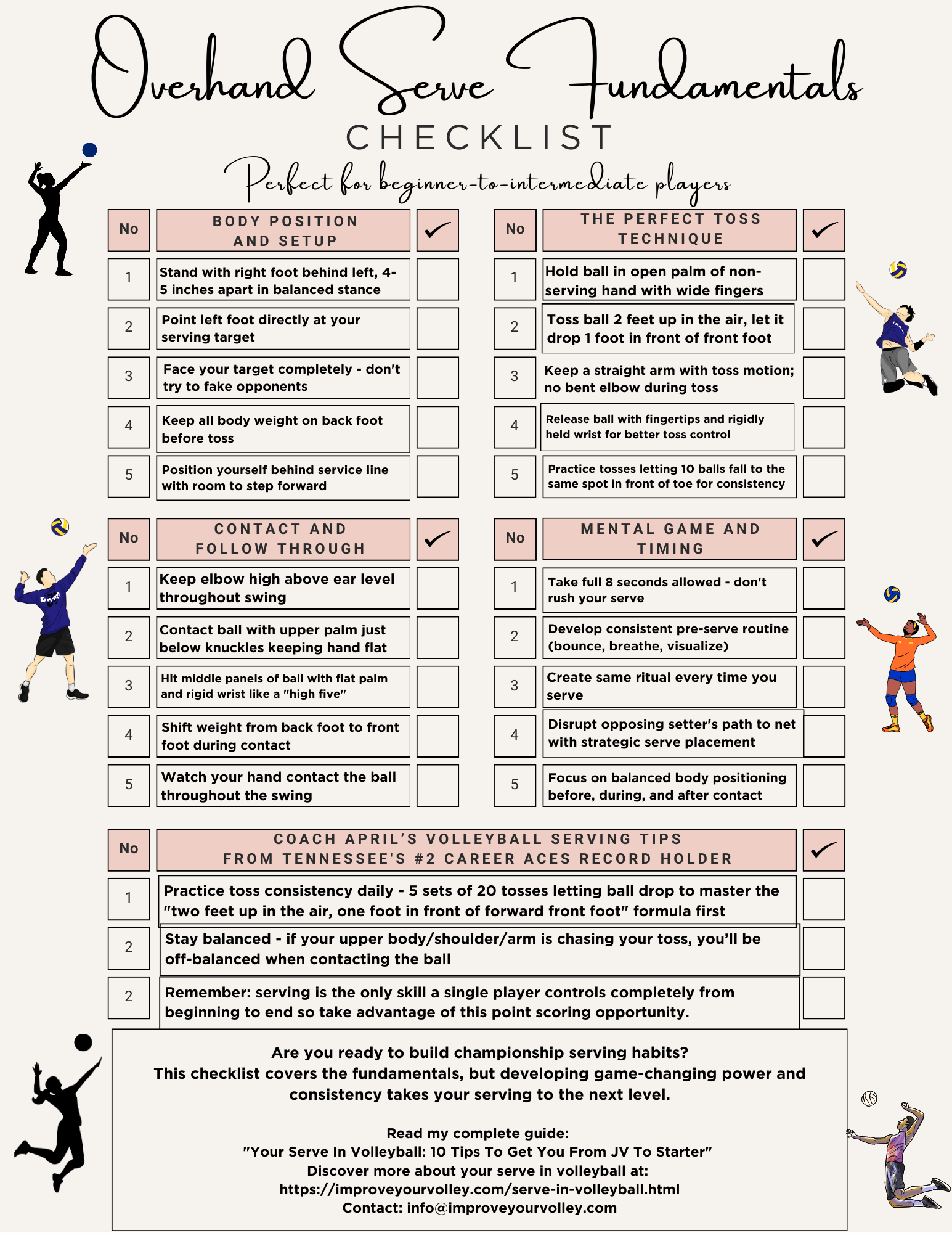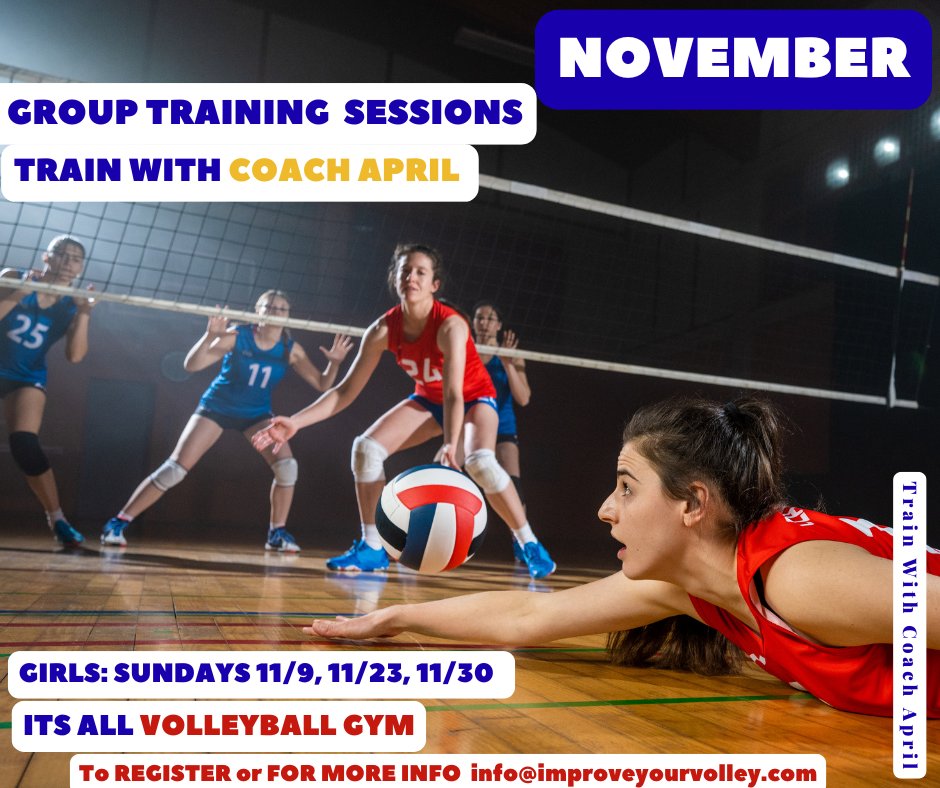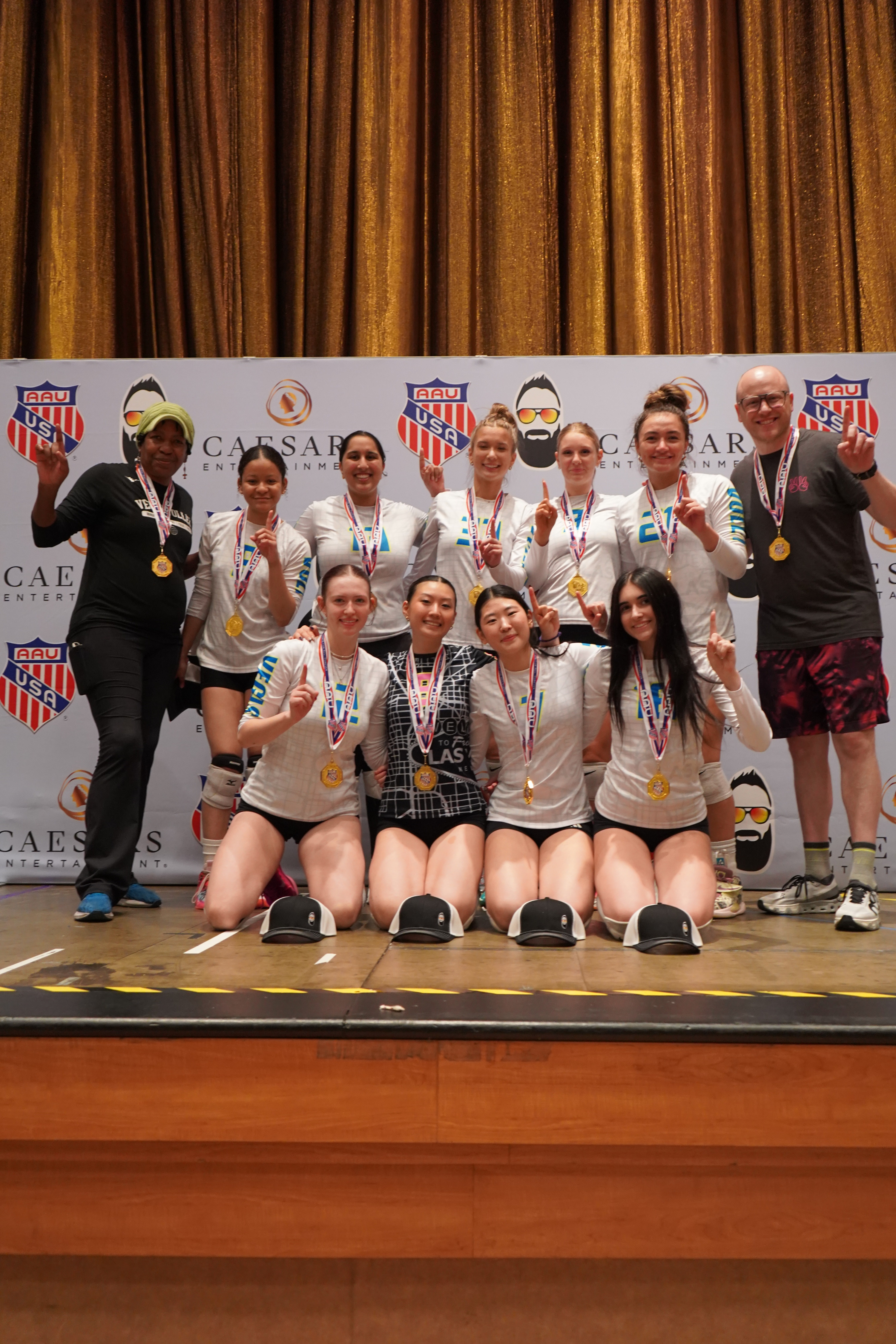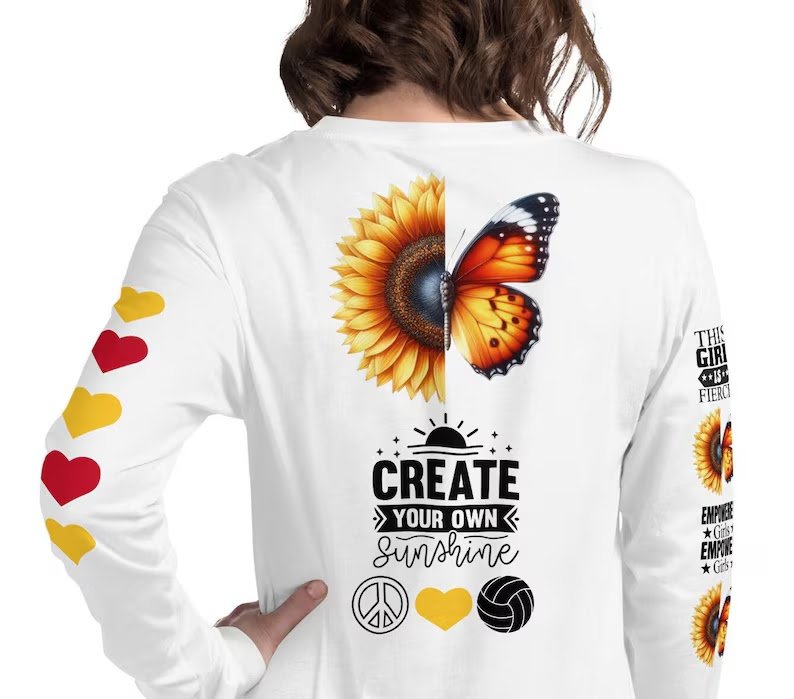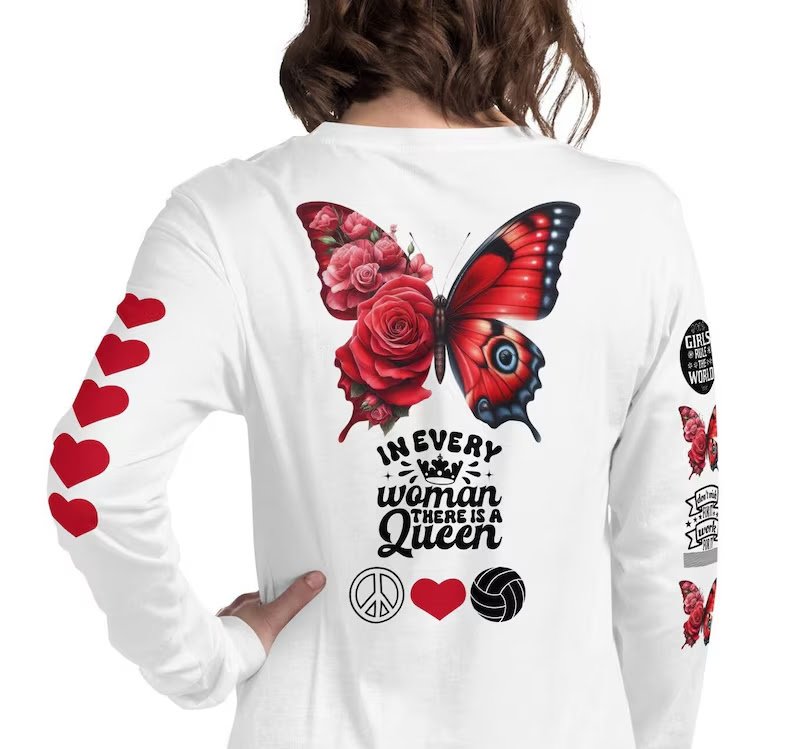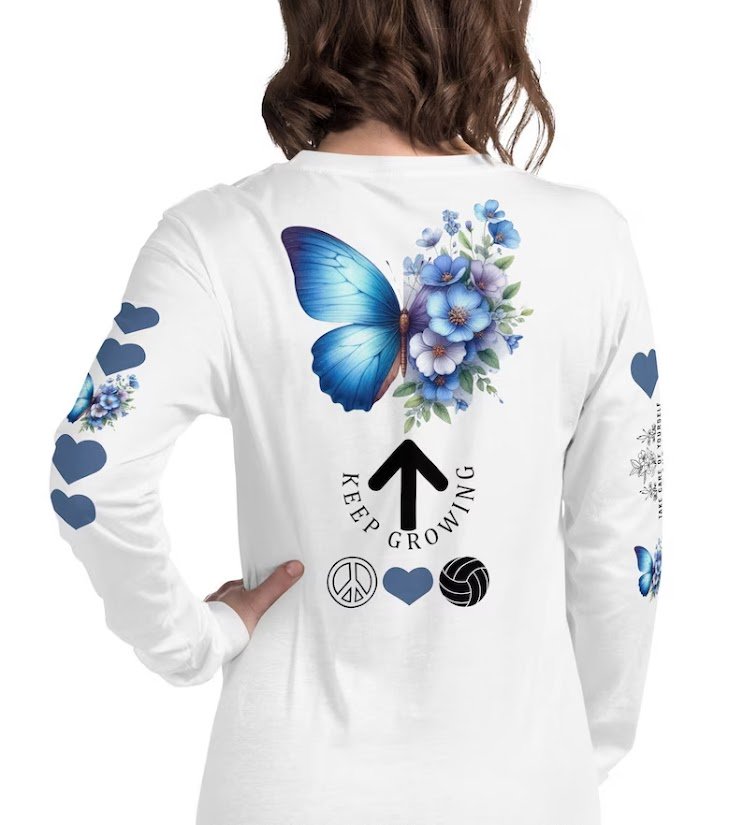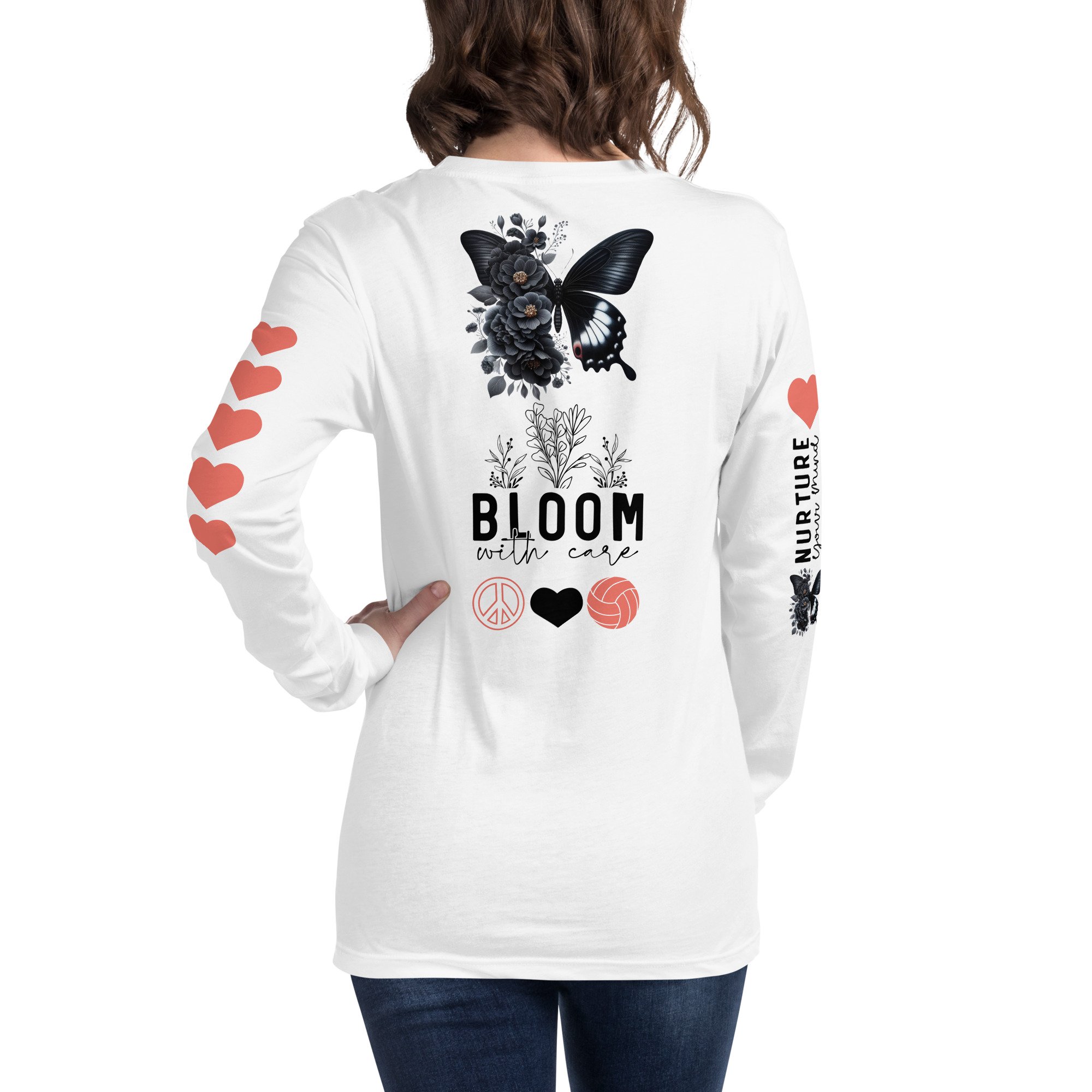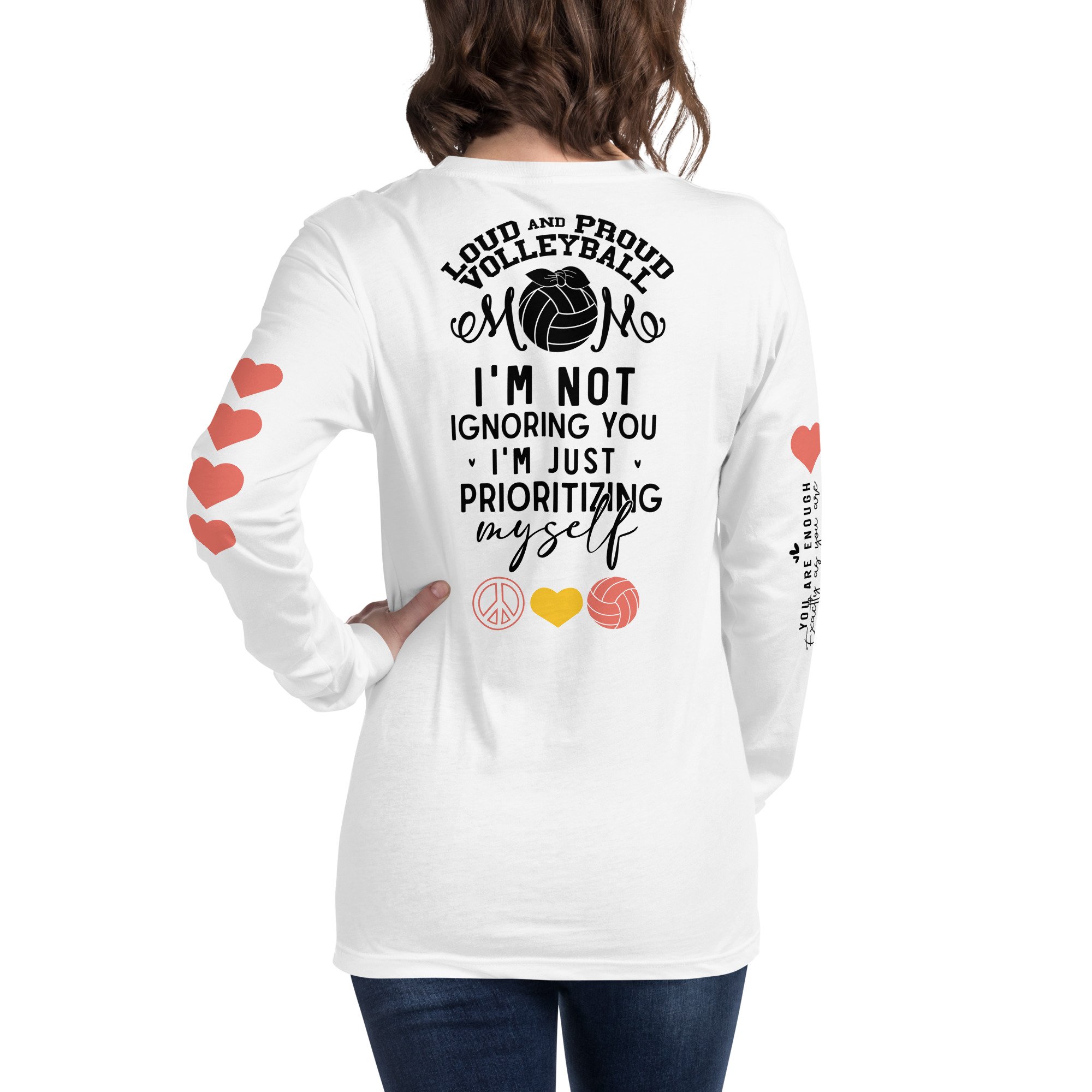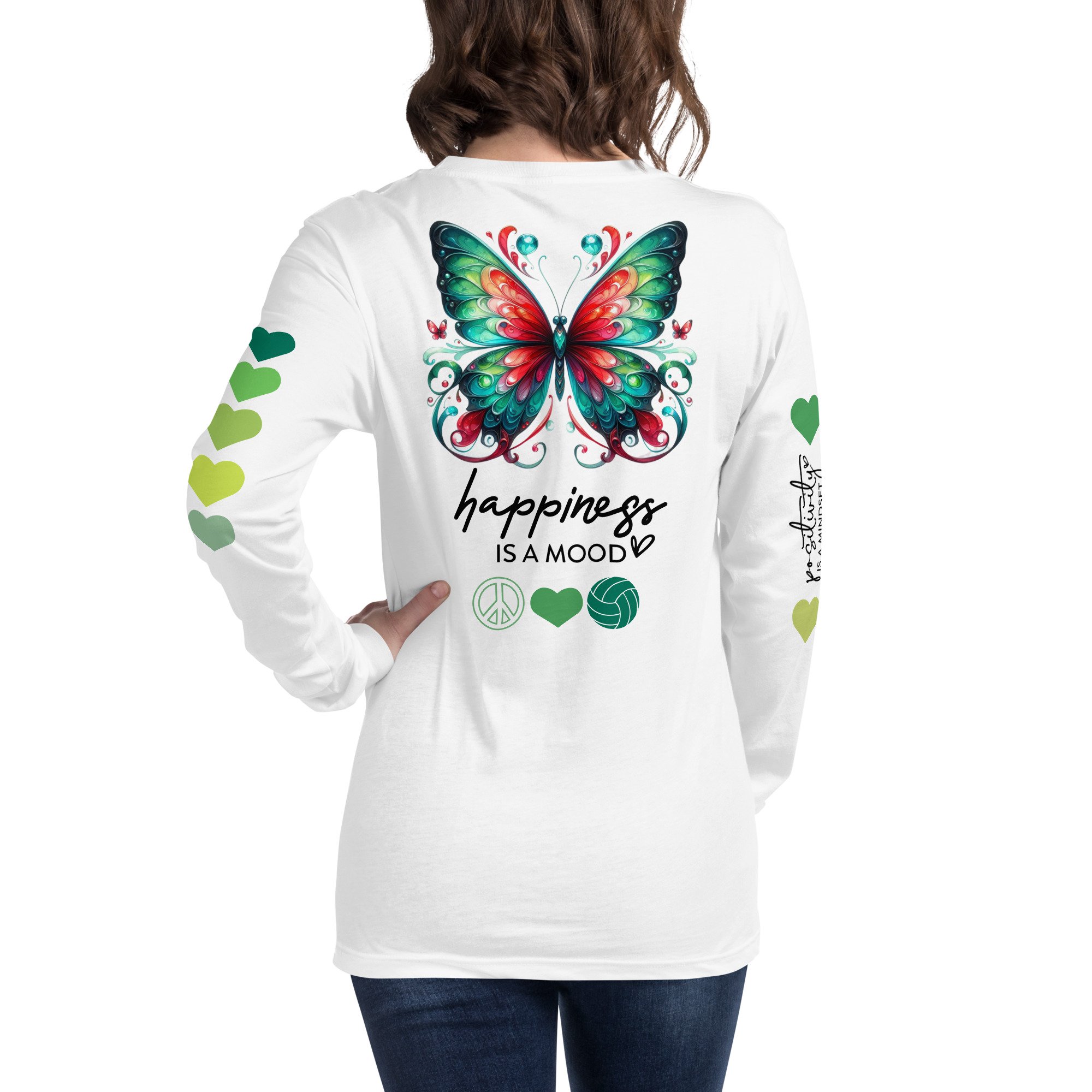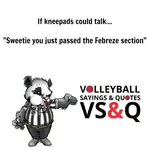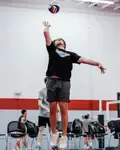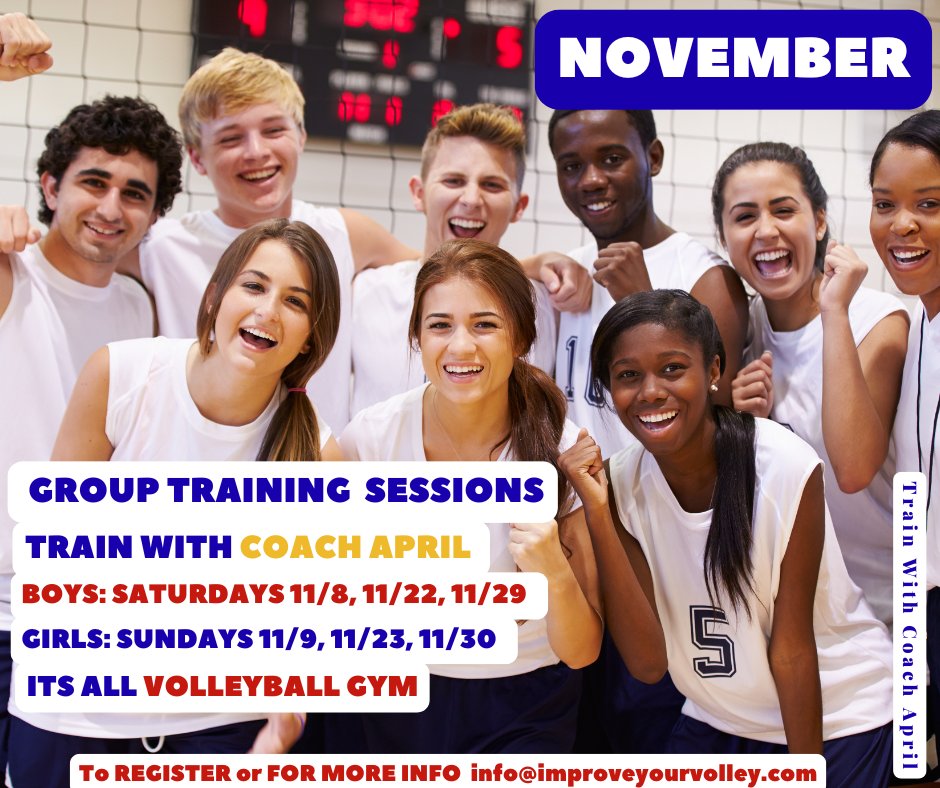 NOVEMBER Group Training with Coach April
Registration is NOW open for Group Training Sessions with me Coach April For BOYS on SATURDAYS 11/8, 11/22, 11/29
For GIRLS on SUNDAYS 11/9, 11/23, 11/30
From 10-11am at the Its All Volleyball gym.
Email: info@improveyourvolley.com to register or for more information
NOVEMBER Group Training with Coach April
Registration is NOW open for Group Training Sessions with me Coach April For BOYS on SATURDAYS 11/8, 11/22, 11/29
For GIRLS on SUNDAYS 11/9, 11/23, 11/30
From 10-11am at the Its All Volleyball gym.
Email: info@improveyourvolley.com to register or for more information- Improve Your Volleyball with Coach April
- Volleyball Uniforms
- Mizuno Volleyball Knee-pads
Are the Mizuno Volleyball Knee-pads The Best Volleyball Kneepads?
Elite coach with pro experience reviews Mizuno volleyball knee-pads with position-specific T-10 Plus and LR6 breakdown. Your definitive 2026 kneepad preview.
After playing professionally in Italy, competing on the USA National Team, and now coaching top-level 18s club volleyball in Las Vegas, I've worn more Asics, Under Armour and Mizuno volleyball knee-pads than I can count.
Today I want to dive deeper into why I believe that Mizuno volleyball knee-pads should be at the top of your shopping list this season, so let me cook while I break down various models that work best for your player's position and skill level.
Look, I get it.
You're standing in the sporting goods store or scrolling through websites, staring at dozens of volleyball kneepads wondering which ones will actually protect your player's knees without sliding down their legs mid-match.
As a former first-round draft pick in the first USA women's professional volleyball league and now a UT Knoxville Hall of Fame inductee, I've been sponsored by Mizuno, Asics, Champion, and other top brands throughout my career.
But there's a reason Mizuno volleyball apparel and equipment consistently ranks number one in kneepad reviews year after year.
The biggest pain point I hear from parents and players is simple: "Coach, my knee pads keep falling down!"
Nothing kills a player's confidence faster than having to stop mid-rally to pull up their kneepads.
This isn't just annoying - it's extremely distracting.
When you're diving for a ball, you need to trust your equipment completely.
That split-second distraction of adjusting your gear can mean the difference between making a game-saving dig and watching the ball hit the floor.
Why The Position You Play Matters When Choosing Your Next Pair of Mizuno Volleyball Knee-pads
Let's talk about why position matters when choosing the best kneepads for volleyball.
As a former world-class six-rotation outside hitter who spent countless hours hitting the floor while playing defense, I can tell you that liberos, setters, and outside hitters need different features than middle blockers.
This is something most equipment reviewers completely miss because they've never played at an elite level or coached competitive club volleyball.
Liberos hit the floor more than any other position - sometimes 50-60 times in a single match. That's not an exaggeration.
When I coach my liberos, I'm watching them pancake, roll, and dive repeatedly throughout practice and matches.
Their knees take an absolute beating. This is why the padding density and coverage area of your volleyball kneepad matters so much for defensive specialists.
What Makes Mizuno Volleyball
Knee-Pads Actually Work For Competitive Play
The Mizuno T-10 Plus knee pad has become the gold standard in our sport, and I'm going to break down exactly why.
But first, let's understand what makes a kneepad volleyball pair actually work for competitive play.
You need five critical features:
- padding density
- proper rise height
- full patella coverage
- anti-slip technology
- right sleeve length for your position
Padding Density
Padding density is probably the most misunderstood feature. Thicker doesn't always mean better.
You need dense foam that compresses on impact but returns to its original shape quickly.
The Mizuno LR6 kneepad uses VS-1 padding technology - that's their high-density foam that absorbs shock without making you feel like you're wearing pillows on your knees. This technology is the result of decades of research with professional players.
High Rise vs Low Rise
High rise versus low rise is another huge decision point that causes confusion for parents.
Low-rise kneepads sit just below your kneecap, while high-rise versions extend several inches above it.
For middle school players who are still learning proper falling technique, I usually recommend high-rise options because they offer more coverage as kids figure out their body mechanics and build confidence hitting the floor.
By high school and club volleyball, most players have developed their preferred style and movement patterns.
Outside hitters and liberos who are constantly diving often prefer low-rise because they want maximum mobility.
But here's the catch - you can't sacrifice coverage for mobility. This is where Mizuno's design really shines compared to other brands.
The Mizuno volleyball kneepad line offers both options, but their T-10 Plus model has this perfect sweet spot.
It's technically a low-rise design, but the patella coverage extends far enough that you're getting protection without the bulky feel.
When I was playing professionally in Italy and competing in the finals of the Italian Division 1 championships, this kind of design didn't exist yet, and I wish it had.
Slippage
Let's address the slippage issue head-on because this is the number one complaint I hear about Nike volleyball kneepads and even some Adidas volleyball kneepads.
No matter how good the padding is, if your kneepads are sliding down during play, they're useless.
Worse than useless, actually, because now your player is distracted, their timing is off, and they're not fully protected when they need it most.
Mizuno solved this problem with their compression sleeve construction. The T-10 Plus uses a sleeve design that grips your leg without cutting off circulation.
That's the difference between good equipment and great equipment - it performs when conditions get tough.
Physics doesn't lie: compression technology either works under game conditions or it doesn't, and five years of consistent top ratings prove Mizuno's design works.
Now, I'm not saying other brands don't make quality products. Nike essential volleyball kneepads have their fans, and Under Armour has entered the volleyball market with some interesting compression technology.
But when you compare features side by side - which we'll do in detail below - you'll see why I keep coming back to Mizuno for my players.
Sleeve Length
The knee sleeve length question comes up constantly from parents shopping for their players. Short sleeves are great for players who run hot or compete in warm gyms.
Long sleeve kneepad lengths offer more coverage and can help with floor burns on your lower calf.
For club volleyball where you're playing in different venues every weekend with varying temperatures, I usually recommend the standard length that Mizuno offers - it's versatile enough for most situations.
Last season, I had a libero who was getting bruised knees despite wearing a well-known brand of kneepads.
We switched her to the Mizuno LR volleyball kneepad, and within two weeks, the bruising stopped completely. Same player, same diving technique, different protection level. That's the Mizuno difference in real-world performance.
For middle school players just starting out in competitive volleyball, the Mizuno slider kneepad is an excellent entry point.
It has solid padding, good coverage, and a price point that makes sense when your player is still growing and you're buying new equipment every season.
But here's my advice - if your middle schooler is serious about volleyball and playing club, invest in the T-10 Plus from the start.
Why Invest In The Best Volleyball Kneepads For Youth Players
Okay so here's an important question.
Why invest more upfront for younger players?
Because cheap kneepads create bad habits that are incredibly hard to break later. When players don't trust their equipment, they hesitate before diving. That split-second hesitation can become ingrained in their muscle memory.
Why Investing In The Best Volleyball Kneepads For High School and Club Players
High school and club volleyball players need to understand that their kneepads are as important as their shoes.
You wouldn't play in cheap shoes that don't fit right and hurt your feet, so why wouldn't you protect your knees - which you need for your entire life - with inferior padding?
The Mizuno T-10 Plus costs more upfront, but you're investing in injury prevention and confidence building.
What Volleyball Kneepads Should College and Adult Players Invest In?
College and adult players have usually figured out what works for their body through years of trial and error, but I still see players at this level making equipment mistakes.
The best volleyball kneepads for advanced players need to balance protection with performance.
You can't have so much padding that it affects your movement speed and vertical jump, but you can't sacrifice protection either.
Mizuno Volleyball Knee-pads Engineering
This is where Mizuno's engineering really stands out from competitors.
Their VS-1 padding technology provides maximum protection with minimum bulk. When you're playing at a high level like I did with the New York Liberties and on the USA National Team, every millisecond matters.
Heavy, bulky kneepads may feel like they slow some players down and affect their timing. The T-10 Plus gives you protection without the performance penalty.
White Mizuno Volleyball Knee-Pads:
Why Color Matters
One universal truth in volleyball: your equipment either builds confidence or destroys it—there's no middle ground when you're diving for balls.
Let's talk specifically about the Mizuno white kneepads because color matters more than you might think.
White shows dirt and floor marks, which means you can see exactly where impact is happening on your kneepads.
This helps you assess whether your kneepads are positioned correctly and if you need to adjust your technique or equipment placement.
Beyond that practical consideration, many club volleyball teams require white kneepads for uniformity and professional appearance.
Mizuno offers their top models including the T-10 Plus in white, which means you don't have to compromise on quality to match your team's uniform requirements.
Some volleyball kneepad brands force you to choose between their best technology and the color you need - as far as I'm concerned that's unacceptable.
What Type Of Mizuno Volleyball Knee-pads Do Setters Look For?
Now I want to address a specific pain point for setters that nobody talks about.
While setters do a lot of diving but not quite as much as liberos, they do drop to their knees constantly when setting balls off the net or chasing down errant passes.
This repetitive kneeling motion requires different padding characteristics than diving. The constant compression needs foam that won't bottom out after repeated impact.
The Mizuno LR6 kneepad works beautifully for setters because the padding density supports repeated compression without losing its protective qualities.
When I work with my setters, I watch them drop to their knees dozens of times per practice. Over a season, that's thousands of impacts.
Your setter needs kneepads that will maintain their protection level from the first tournament in November through championships in July.
Outside Hitters Want Their Mizuno Volleyball Knee-pads Designed To Do What?
They need to be explosive for their approach and vertical jump while also being ready to dig balls in the back row.
When I played outside hitter, I needed kneepads that wouldn't restrict my jumping motion but would still protect me when I transitioned to defense.
The low-profile design of the Mizuno T-10 Plus addresses this exact need for outside hitters.
The padding is dense enough to protect during digs but streamlined enough that it doesn't interfere with your approach footwork or arm swing.
This balance is critical for outside hitters who are asked to do everything - hit, pass, dig, and serve - at a high level.
Here's an irrefutable fact: equipment that stays in place performs better than equipment that doesn't—100% of the time, no exceptions.
What Type Of Mizuno Volleyball Knee-pads Do Middle Blockers Need?
Middle blockers might think they don't need premium kneepads since they're not diving as much as back-row players, but here's what I tell my middles: you're one bad read away from an emergency dig, especially if you're the middle blocker have to go back to serve.
Every volleyball player hits the floor eventually—it's not a matter of if, but when, and that moment reveals whether you invested in real protection or just padding.
Plus, blocking footwork means you're constantly in an athletic stance with bent knees. Proper padding reduces fatigue on your knee joints throughout long tournament days.
Why Shop Mizuno Volleyball Knee-Pads? The Brand Difference
When you shop Mizuno, you're not just buying kneepads - you're buying decades of research and development specifically for volleyball.
Mizuno has been a leader in volleyball equipment since before I started playing in the 1980s.
They sponsor national teams and professional leagues worldwide, which means they're constantly getting feedback from elite athletes and improving their products based on real performance data.
The technology in the T-10 Plus didn't happen by accident or in a generic sports lab.
It's the result of working with players at every level to understand what actually works on the court.
The compression sleeve design, the VS-1 padding, the anatomical shaping - these features exist because players like me told Mizuno what we needed, and their engineers listened and delivered.
Me and Mizuno Volleyball Kneee-pads
Let me compare this to my experience with other brands throughout my career.
When I was sponsored by different companies, I noticed that volleyball-specific features were often missing. Some brands would take their basketball or wrestling kneepads and market them for volleyball.
That doesn't work.
Volleyball movements are unique - the angles, the impact patterns, the duration of wear - and you need equipment designed specifically for our sport.
Mizuno volleyball apparel is designed by people who understand volleyball at the highest levels.
That might sound obvious, but it's not universal across brands.
The difference shows up in details like the curve of the padding to match your kneecap shape, or the placement of the compression zones to prevent slippage during lateral movement and quick direction changes.
Here's an irrefutable fact: the Mizuno T-10 Plus has been one of the top-rated Mizuno volleyball knee pads in independent reviews for five consecutive years.
That's not marketing hype from the company - that's consistent performance across thousands of players at every level from middle school to professional.
When something works that well for that long, you pay attention.
For parents shopping for their players, I know budget is a real consideration.
Quality volleyball kneepads typically cost between $20-40 per pair.
The Mizuno T-10 Plus sits at the higher end of that range, but here's how I think about it as both a coach and a parent: you're paying about $10-15 more than basic options for significantly better protection, durability, and performance.
Those cheaper kneepads might last one season if you're lucky, and the padding often compresses and loses effectiveness after just a few months of heavy use.
The T-10 Plus, with proper care, can last multiple seasons. The padding maintains its density, the sleeve doesn't stretch out, and the construction holds up to repeated washing.
When you calculate cost per use, premium Mizuno kneepads are actually more economical.
How To Wash and Care For Your Mizuno Volleyball Knee-pads
Washing and care matter more than most people realize when it comes to kneepad longevity.
Volleyball kneepads take a beating - they're absorbing sweat, hitting gym floors, thrown under benches and get stuffed into equipment bags.
The Mizuno slider kneepad and T-10 Plus both use materials that maintain their shape and compression properties through repeated washing cycles.
I tell my players to wash their kneepads after every practice and match.
This isn't just about hygiene, though that matters too - it's about maintaining the equipment's performance.
The elastic fibers in quality kneepads need to be cleaned regularly to maintain their grip and compression.
Mizuno's materials are specifically designed for this kind of regular maintenance without breaking down.
Sizing Your Mizuno Volleyball
Knee-pads: The Complete Guide
Let's look at sizing because this trips up a lot of families when ordering online.
Measure carefully with a soft tape measure - too tight and you'll cut off circulation and create discomfort, too loose and they'll slide down during play.
When in doubt, I recommend sizing up for growing middle school players.
They'll get more use out of the kneepads as they grow, and a slightly looser fit is better than too tight.
The anatomical design of Mizuno volleyball knee-pads means they fit differently on your right and left leg.
Some cheaper brands use the same pattern for both sides to save manufacturing costs, but your legs aren't symmetrical.
The T-10 Plus accounts for this with left and right specific shaping. It's a small detail that makes a huge difference in comfort during long matches and tournaments.
Under Armour, Nike and Mizuno Volleyball Knee-pads
Now let's talk about the comparison between Mizuno, Nike, and Under Armour because you're probably shopping around and seeing all three brands.
Each has strengths, but for volleyball-specific performance, there's a clear winner.
Nike volleyball kneepads, particularly their Essential line, are popular because Nike has strong brand recognition and wide distribution.
They're easy to find, and the price point is attractive for budget-conscious families.
However, Nike's focus is spread across dozens of sports, and volleyball isn't their primary market.
This shows up in the details - the padding density isn't optimized for volleyball-specific impacts, and the anti-slip technology doesn't perform as well during extended play.
Under Armour has made a push into volleyball in recent years with some innovative designs, and their compression technology is excellent across all their products.
But Under Armour is still relatively new to volleyball-specific equipment, and they don't have the decades of player feedback that Mizuno has built into their designs.
When you're choosing between brands, ask yourself: do I want kneepads from a company that makes everything, or from a company that specializes in volleyball and has been perfecting their products for over 40 years?
The best kneepads for volleyball need to excel in every category we've discussed: padding density, coverage, anti-slip performance, durability, and position-specific design.
When I evaluate equipment for my players who are working toward college scholarships, I'm not looking for good enough - I'm looking for the best.
These athletes are investing thousands of hours into their development, and their equipment needs to support those goals.
In Conclusion
As a former professional player who competed in Italy's Division 1 championships and on the USA National Team, I've had the privilege of being sponsored by Mizuno throughout significant portions of my career.
I've worn Mizuno volleyball knee pads, apparel, and shoes in some of the most competitive environments in the world, so my recommendations come from genuine first-person experience, not just coaching observation.
Currently, I'm a Mizuno affiliate, which means many of the links on this page are affiliate links—when you purchase through them, I earn a commission at no extra cost to you.
This allows me to continue providing in-depth, honest equipment reviews based on my decades of elite-level experience.
Whether you're shopping during Black Friday, Cyber Monday, Christmas, or gearing up for the 2026 club volleyball season, I encourage you to **shop Mizuno** for volleyball knee pads that will genuinely protect your investment in this sport.
The T-10 Plus, LR6, and Slider models I've recommended aren't just products I'm promoting—they're equipment I've trusted with my own knees and now trust with my players' knees.
When you're ready to invest in knee pads that perform at the highest level, click any of the Mizuno links on this page to find the right model for your position and skill level.
Do You Follow Me on Pinterest?
Follow me on Pinterest Volleybragswag to improve your game even faster!
I share alot of individual, partner and easy-to-do volleyball serving drills we do in class with my followers.
Many of these volleyball practice drills you can do at home by yourself or try at your next practice with your teammates.
If you're a B team or JV player trying to make varsity next year...your goal should be to complete 1000 reps a day of at least three of the basic skills on your own...volleyball passing, serving and setting should be at the top of the list.
If your athlete struggles with consistent serve receive, gets subbed out, or is overlooked for playing time—this is the fix you’ve been looking for.

Struggling with passing consistency?
I help talented passers tired of getting pulled from games because of inconsistent serve receive skills BUILD passing confidence without expensive private lessons using the same 3-step system that's helped dozens of my athletes get recruited.
Download my eBook for $17.99 and start building the passing confidence that keeps you on the court—and gets you seen by college coaches.
From Lady Vol to Legend: Coach April Produces Powerful Passionate Players...is that you?

What Are You Looking For?
Click to Download Your Pre Serving Ritual Mastery Checklist pdf:
🎯Volleyball Pre Serving Ritual Guide -
Players! Learn How To Transform Your Serve from Weak to Weapon
Click to Download Your Parent's Volleyball Serving Checklist pdf
🎯Parent's Volleyball Serving Checklist Guide
Parents! Help Your Player Develop Championship Serves (Even If You've Never Played)

Hi there!
Thanks for stopping by. Hope you learned something today that will help you reach your volleyball goals.
Be sure to subscribe to my email newsletter so you can learn more each week!
Stay strong! Stay motivated!
-Coach April

SUSCRIBE to my email newsletter below!

 Click to learn more about the weekly volleyball classes and clinics or email info@imrpoveyourvolley.com for information
Click to learn more about the weekly volleyball classes and clinics or email info@imrpoveyourvolley.com for informationCongratulations to my seven Boys-18s Vegas Volley club players who played in two state championship finals yesterday, the 3A and 5A State champinship finals at Sunrise Mountain High School.
TOURNAMENT CHAMPIONS!
A-1 Vegas Volley VBC
In It To Win It Tournament
May 2 - 4, 2025 Tournament
Gold Medalists
18s Premier Division
Vegas Volleyball's Unsung Heroes: Celebrating Moms with Peace Love Volleyball Shirts
Ready to energize your volleyball mom journey?
Subscribe to my 'Producing Powerful Passionate Peaceful Players' email list above on ImproveYourVolley.com.
You'll receive energy-boosting tips, exclusive insights from me, Coach April Chapple on maintaining momentum in volleyball.
Let's power up the Vegas volleyball scene together!
Recent Articles
-
Are the Mizuno Volleyball Knee-pads The Best Volleyball Kneepads?
Nov 22, 25 08:37 PM
Elite coach with pro experience reviews Mizuno volleyball knee-pads with position-specific T-10 Plus and LR6 breakdown. Your definitive 2026 kneepad preview. -
Mizuno Knee pads Which Knee pads Are Best For Volleyball Club Players?
Nov 22, 25 08:34 PM
Here's my review of the Mizuno knee pads so you can make a comparison between which ones have the best type of knee coverage you're looking for on the court. -
The Volleyball Jump Serve Serving Harder To Score Aces On Varsity
Nov 20, 25 05:31 PM
The volleyball jump serve used on high school varsity volleyball teams is either a jump float or a jump topspin done with a spike approach before the swing.
